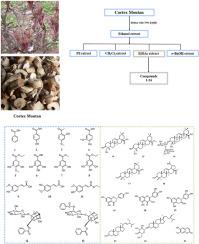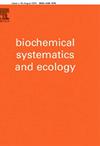毛坦皮质中的化学成分及其化学分类学意义
IF 1.4
4区 生物学
Q4 BIOCHEMISTRY & MOLECULAR BIOLOGY
引用次数: 0
摘要
通过对 Cortex Moutan(Paeonia suffruticosa Andrews 的干燥根皮)进行植物化学研究,分离出 24 种化合物,包括 11 种单酚类化合物(1-11)、7 种萜类化合物(12-18)、3 种黄酮类化合物(19-21)、2 种甾醇类化合物(22 和 23)以及 1 种香豆素类化合物(24)。这些分离化合物的结构是通过核磁共振光谱(1H 和 13C)与以前报告的数据进行比较后确定的。据我们所知,化合物 5、11、15、16、22 和 24 是首次从该植物中发现。此外,还讨论了分离物的化学分类学意义。本文章由计算机程序翻译,如有差异,请以英文原文为准。

Chemical constituents from Cortex Moutan and their chemotaxonomic significance
A phytochemical study of Cortex Moutan (the dried root bark of Paeonia suffruticosa Andrews) led to the isolation of 24 compounds, including eleven mono-phenols (1–11), seven terpenoids (12–18), three flavonoids (19–21), two sterols (22 and 23) and one coumarin (24). The structures of these isolated compounds were identified using NMR spectroscopy (1H and 13C) by comparison with previously reported data. To the best of our knowledge, compounds 5, 11, 15, 16, 22, and 24 were reported from this plant for the first time. The chemotaxonomic significance of the isolates was also discussed.
求助全文
通过发布文献求助,成功后即可免费获取论文全文。
去求助
来源期刊

Biochemical Systematics and Ecology
生物-进化生物学
CiteScore
3.00
自引率
12.50%
发文量
147
审稿时长
43 days
期刊介绍:
Biochemical Systematics and Ecology is devoted to the publication of original papers and reviews, both submitted and invited, in two subject areas: I) the application of biochemistry to problems relating to systematic biology of organisms (biochemical systematics); II) the role of biochemistry in interactions between organisms or between an organism and its environment (biochemical ecology).
In the Biochemical Systematics subject area, comparative studies of the distribution of (secondary) metabolites within a wider taxon (e.g. genus or family) are welcome. Comparative studies, encompassing multiple accessions of each of the taxa within their distribution are particularly encouraged. Welcome are also studies combining classical chemosystematic studies (such as comparative HPLC-MS or GC-MS investigations) with (macro-) molecular phylogenetic studies. Studies that involve the comparative use of compounds to help differentiate among species such as adulterants or substitutes that illustrate the applied use of chemosystematics are welcome. In contrast, studies solely employing macromolecular phylogenetic techniques (gene sequences, RAPD studies etc.) will be considered out of scope. Discouraged are manuscripts that report known or new compounds from a single source taxon without addressing a systematic hypothesis. Also considered out of scope are studies using outdated and hard to reproduce macromolecular techniques such as RAPDs in combination with standard chemosystematic techniques such as GC-FID and GC-MS.
 求助内容:
求助内容: 应助结果提醒方式:
应助结果提醒方式:


